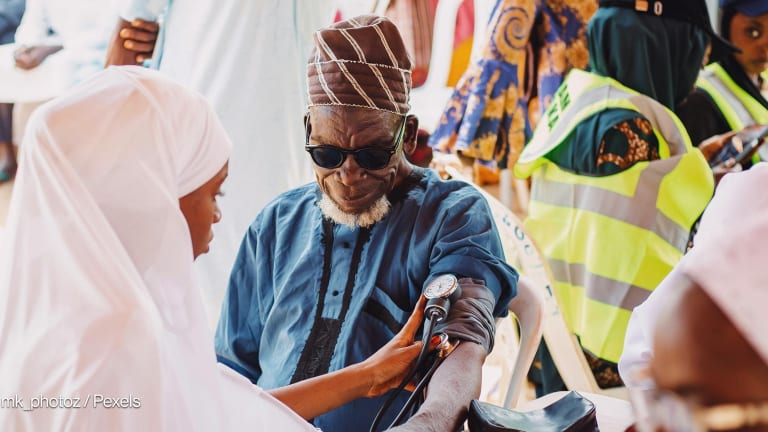Innovation at Save the Children: A return on investment, literally
Devex caught up with Save the Children's innovation lead Kimberly Coletti to learn about how her team's work has stretched across the organization and created new fundraising opportunities.
NEW YORK — Save the Children launched a report at Global Goals Week analyzing two examples of development impact bonds for maternal and child survival interventions. The report is part of Save the Children’s effort to offer more thought leadership, including development finance research and advocacy, said Kimberly Coletti, senior director of innovation at Save the Children. The organization saw a gap in the evidence on how DIBs are applied in the sector and shared its own lessons on the topic at an event during the United Nations General Assembly. As part of Devex’s Meet the Innovation Leads series, we caught up with Coletti ahead of UNGA to learn more about Save’s model to support what it describes as “breakthrough innovations for children.” Before stepping into this innovation role just over two years ago, Coletti was in a number of fundraising roles, including senior director of individual philanthropy. Fundraising remains a key role for the innovation team, in order to finance the kinds of interventions for children that it hopes to bring to scale. In fact, one of the benefits of the innovation program is not just the money it puts out but the money it brings in. Through its innovation accelerator, Save the Children asks staff across the world to submit ideas twice a year. Over the past two years, it has funded 12 innovations with between $20,000 and $100,000 each. But it has also generated 50 ideas in concept notes that the fundraising team then approaches donors to raise money for. Save the Children has given out $800,000 of innovation funding through its accelerator and raised $1.5 million in additional investment, Coletti said. One outcome of this innovation effort is a gel made from chlorhexidine, an ingredient found in antiseptics and mouthwash. The gel can be delivered in single-use packets, without refrigeration, and applied to a cut umbilical cord. Save the Children partnered with the pharmaceutical company GlaxoSmithKline to turn this mouthwash ingredient into a lifesaving treatment for babies. Now, the company is offering the gel at cost and sharing its manufacturing knowledge with other companies interested in producing it. Beyond product development, Save the Children also offers individuals at corporations a way to use their skills for good. Last year, for example, the NGO partnered with Accenture Development Partnerships on a design project focused on the question: “How can digital technologies provide breakthrough solutions for the challenges Save the Children faces in supporting young people to develop secure livelihoods?” This resulted in 90 ideas, three of which were prototyped, and one of which won an investment from Accenture and seed funding from the Save the Children accelerator, and is currently in beta testing in Vietnam. More recently, Save the Children has worked with partners including the Kangaroo Mother Care Acceleration Partnership and Purdue University’s Innovation for International Development Lab on a blueprint for the implementation of “kangaroo mother care,” or skin-to-skin care, in health systems, for example with floor plans that integrate this kind of care into their newborn units. In 2003, the senior management team at Save the Children decided it would focus more of its unrestricted funding to come up with new ideas around programmatic innovation. “We were being quite reactive to innovation opportunities,” Coletti said. “Like many of our international development colleagues around the world, a lot of our work was sometimes dictated by the funding that is available.” Initially, the innovation effort was part of the international programs team, and started by investing resources in developing, piloting, and growing programmatic innovations. Literacy Boost, for example, was a response to the problem that 250 million children cannot read or write by the time they reach the fourth grade. It began as a pilot, with a small amount of innovation funding resulting from a sponsorship, Coletti said. But once it was proven as an intervention that could deliver results for children, it became a common approach for the organization in its work across multiple countries. In 2016, the innovation team moved to the office of the president and CEO, Carolyn Miles, whom Coletti reports to directly, and expanded its focus to include innovations for areas such as fundraising, operations, and marketing. The team is small, but it funds a portion of time for other colleagues, who stay within their program teams but devote some of their time toward working on new ideas. “We’re of the mindset: let’s keep ourselves lean, manage through influence within each of our technical and functional teams, and be as agile as possible,” she said. The form for Save the Children’s innovation accelerator starts by asking: What is the problem you are trying to solve? “Though it is simple, it actually really helps people frame their ideas,” she said. The next questions are: Can it lead to breakthroughs for children? What challenges might come up? What is the idea? Is it a disruptive or incremental innovation? And does Save the Children have the capacity to do it? “We all hope we can go and have the disruptive innovation that helps children, but we’re realistic that actually a lot of progress can be made with incremental innovation, and that’s usually with an incremental programmatic approach,” Coletti said.
NEW YORK — Save the Children launched a report at Global Goals Week analyzing two examples of development impact bonds for maternal and child survival interventions. The report is part of Save the Children’s effort to offer more thought leadership, including development finance research and advocacy, said Kimberly Coletti, senior director of innovation at Save the Children. The organization saw a gap in the evidence on how DIBs are applied in the sector and shared its own lessons on the topic at an event during the United Nations General Assembly.
As part of Devex’s Meet the Innovation Leads series, we caught up with Coletti ahead of UNGA to learn more about Save’s model to support what it describes as “breakthrough innovations for children.”
Before stepping into this innovation role just over two years ago, Coletti was in a number of fundraising roles, including senior director of individual philanthropy. Fundraising remains a key role for the innovation team, in order to finance the kinds of interventions for children that it hopes to bring to scale. In fact, one of the benefits of the innovation program is not just the money it puts out but the money it brings in.
This story is forDevex Promembers
Unlock this story now with a 15-day free trial of Devex Pro.
With a Devex Pro subscription you'll get access to deeper analysis and exclusive insights from our reporters and analysts.
Start my free trialRequest a group subscription Printing articles to share with others is a breach of our terms and conditions and copyright policy. Please use the sharing options on the left side of the article. Devex Pro members may share up to 10 articles per month using the Pro share tool ( ).
Catherine Cheney is the Senior Editor for Special Coverage at Devex. She leads the editorial vision of Devex’s news events and editorial coverage of key moments on the global development calendar. Catherine joined Devex as a reporter, focusing on technology and innovation in making progress on the Sustainable Development Goals. Prior to joining Devex, Catherine earned her bachelor’s and master’s degrees from Yale University, and worked as a web producer for POLITICO, a reporter for World Politics Review, and special projects editor at NationSwell. She has reported domestically and internationally for outlets including The Atlantic and the Washington Post. Catherine also works for the Solutions Journalism Network, a non profit organization that supports journalists and news organizations to report on responses to problems.








